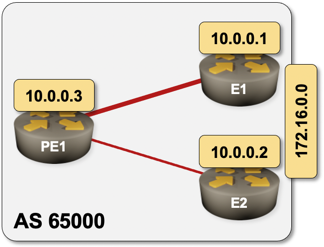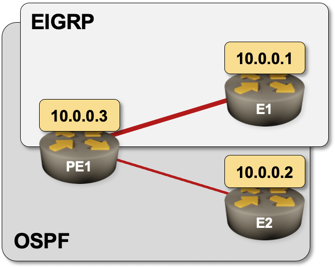IBGP, IGP Metrics, and Administrative Distances
TL&DR: If you run multiple IGP protocols in your network, and add BGP on top of that, you might get the results you deserve. Even better, the results are platform-dependent.
One of my readers sent me a link to an interesting scenario described by Jeremy Filliben that results in totally unexpected behavior when using too many routing protocols in your network (no surprise there).
Imagine a network in which two edge routers advertise the same (external) BGP prefix. All other things being equal, it would make sense that other routers in the same autonomous system should use the better path out of the autonomous system. Welcome to the final tie-breaker in BGP route selection process: IGP metric.

Simplest possible network demonstrating BGP interaction with IGP metric
When using a single routing protocol, BGP selects the closer AS exit point. BGP table on PE1 has two (almost) identical entries, the only difference being the IGP metric toward the BGP next hop. The path with the lower IGP metric is selected.
BGP routing table entry for 172.16.0.0/16, version 4
Paths: (2 available, best #2, table default)
Not advertised to any peer
Refresh Epoch 1
Local
10.0.0.2 (metric 101) from 10.0.0.2 (10.0.0.2)
Origin IGP, metric 0, localpref 100, valid, internal
rx pathid: 0, tx pathid: 0
Refresh Epoch 1
Local
10.0.0.1 (metric 2) from 10.0.0.1 (10.0.0.1)
Origin IGP, metric 0, localpref 100, valid, internal, best
rx pathid: 0, tx pathid: 0x0
Now let’s add EIGRP to the mix. OSPF is running throughout the whole network, EIGRP is running only between PE1 and E1.

Adding EIGRP as the second IGP
pe1#show ip ospf neighbor
Neighbor ID Pri State Dead Time Address Interface
10.0.0.2 1 FULL/BDR 00:00:39 10.1.0.6 GigabitEthernet3
10.0.0.1 1 FULL/BDR 00:00:34 10.1.0.2 GigabitEthernet2
pe1#show ip eigrp neighbors
EIGRP-IPv4 Neighbors for AS(1)
H Address Interface Hold Uptime SRTT RTO Q Seq
(sec) (ms) Cnt Num
0 10.1.0.2 Gi2 14 00:00:15 1 100 0 3
Not surprisingly, the route to E1 is now learned through EIGRP, and the route to E2 is still an OSPF route:
pe1#show ip route 10.0.0.0 255.255.255.0 longer-prefixes
[...]
Gateway of last resort is 192.168.121.1 to network 0.0.0.0
10.0.0.0/8 is variably subnetted, 7 subnets, 2 masks
D 10.0.0.1/32 [90/130816] via 10.1.0.2, 00:02:59, GigabitEthernet2
O 10.0.0.2/32 [110/101] via 10.1.0.6, 03:55:39, GigabitEthernet3
C 10.0.0.3/32 is directly connected, Loopback0
And now for the (not so) big surprise: BGP best path to the external destination goes over the slower link to E2:
pe1#show ip bgp 172.16.0.0
BGP routing table entry for 172.16.0.0/16, version 8
Paths: (2 available, best #1, table default)
Not advertised to any peer
Refresh Epoch 1
Local
10.0.0.2 (metric 101) from 10.0.0.2 (10.0.0.2)
Origin IGP, metric 0, localpref 100, valid, internal, best
rx pathid: 0, tx pathid: 0x0
Refresh Epoch 1
Local
10.0.0.1 (metric 130816) from 10.0.0.1 (10.0.0.1)
Origin IGP, metric 0, localpref 100, valid, internal
rx pathid: 0, tx pathid: 0
As expected: when you over-complicate your network design, you get the troubleshooting experience you were looking for.
What’s Going On?
In a nutshell:
- When selecting identical prefixes from multiple routing protocols, the prefix with the lowest administrative distance is used and appears in the routing table.
- When calculating BGP best paths, BGP takes IGP metric from the IP routing table and it just so happens that a good EIGRP metric is higher than a not-so-good OSPF metric, and so a BGP next hop learned by OSPF is preferred over a BGP next hop learned by EIGRP.
Please note that this behavior is not IGP-specific. You get the same results as long as the network-wide routing protocol has higher administrative distance and lower metrics than the additional routing protocol - it’s easy to reproduce it using IS-IS as the primary routing protocol and OSPF running between PE1 and E1.
Other Platforms
Nexus OS behaves in exactly the same way as Cisco IOS (tested with OSPF and IS-IS), but it seems like vEOS takes administrative distance in account when comparing IGP costs.
I configured OSPF and IS-IS on Arista vEOS 4.25.0FX-LDP-RSVP (with OSPF taking the role of EIGRP in the above example). These are the entries from the main IP routing table:
pe1#show ip route 10.0.0.0/24 longer-prefixes
[...]
O 10.0.0.1/32 [110/101] via 10.1.0.2, Ethernet1
I L2 10.0.0.2/32 [115/30] via 10.1.0.6, Ethernet2
C 10.0.0.3/32 is directly connected, Loopback0
Regardless of the lower IGP cost, the next hop reachable via OSPF (lower admin distance) is preferred when selecting the best BGP route:
pe1#show ip bgp 172.16.0.0/16 detail
BGP routing table information for VRF default
Router identifier 10.0.0.3, local AS number 65000
BGP routing table entry for 172.16.0.0/16
Paths: 2 available
Local
10.0.0.1 from 10.0.0.1 (10.0.0.1)
Origin IGP, metric 0, localpref 100, IGP metric 101, weight 0, ↩
received 00:05:22 ago, valid, internal, best
Rx SAFI: Unicast
Local
10.0.0.2 from 10.0.0.2 (10.0.0.2)
Origin IGP, metric 0, localpref 100, IGP metric 30, weight 0, ↩
received 00:05:20 ago, valid, internal
Rx SAFI: Unicast
Not best: IGP cost
More Details
Want to try it yourself? The lab topology (using vagrant-libvirt) and device configurations are in netlab-examples GitHub repository.

Very interesting Ivan !!
Looks like Nokia too uses the Routing table's prefix's Admin-distance/Preference as a very early BGP tie-breaker. Check this out @ entry#3: https://infocenter.nokia.com/public/7750SR151R1A/topic/com.sr.unicast/html/bgp.html?cp=19_4_6_1_0#addamr5ieywiaklnc
Cheers/Ciao
Andrea